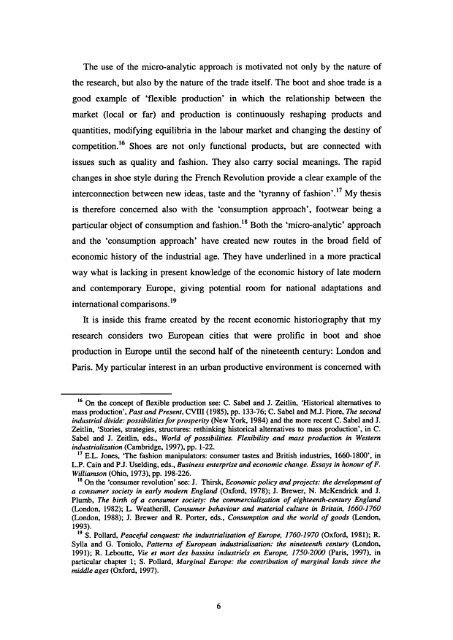The Boot and Shoe Trades in London and Paris in the Long Eighteenth Century
The Boot and Shoe Trades in London and Paris in the Long Eighteenth Century
The Boot and Shoe Trades in London and Paris in the Long Eighteenth Century
You also want an ePaper? Increase the reach of your titles
YUMPU automatically turns print PDFs into web optimized ePapers that Google loves.
<strong>The</strong> use of <strong>the</strong> micro-analytic approach is motivated not only by <strong>the</strong> nature of<br />
<strong>the</strong> research, but also by <strong>the</strong> nature of <strong>the</strong> trade itself. <strong>The</strong> boot <strong>and</strong> shoe trade is a<br />
good example of 'flexible production' <strong>in</strong> which <strong>the</strong> relationship between <strong>the</strong><br />
market (local or far) <strong>and</strong> production is cont<strong>in</strong>uously reshap<strong>in</strong>g products <strong>and</strong><br />
quantities, modify<strong>in</strong>g equilibria <strong>in</strong> <strong>the</strong> labour market <strong>and</strong> chang<strong>in</strong>g <strong>the</strong> dest<strong>in</strong>y of<br />
competition.' 6 <strong>Shoe</strong>s are not only functional products, but are connected with<br />
issues such as quality <strong>and</strong> fashion. <strong>The</strong>y also carry social mean<strong>in</strong>gs. <strong>The</strong> rapid<br />
changes <strong>in</strong> shoe style dur<strong>in</strong>g <strong>the</strong> French Revolution provide a clear example of <strong>the</strong><br />
<strong>in</strong>terconnection between new ideas, taste <strong>and</strong> <strong>the</strong> 'tyranny of fashion'.' 7 My <strong>the</strong>sis<br />
is <strong>the</strong>refore concerned also with <strong>the</strong> 'consumption approach', footwear be<strong>in</strong>g a<br />
particular object of consumption <strong>and</strong> fashion.' 8 Both <strong>the</strong> 'micro-analytic' approach<br />
<strong>and</strong> <strong>the</strong> 'consumption approach' have created new routes <strong>in</strong> <strong>the</strong> broad field of<br />
economic history of <strong>the</strong> <strong>in</strong>dustrial age. <strong>The</strong>y have underl<strong>in</strong>ed <strong>in</strong> a more practical<br />
way what is lack<strong>in</strong>g <strong>in</strong> present knowledge of <strong>the</strong> economic history of late modern<br />
<strong>and</strong> contemporary Europe, giv<strong>in</strong>g potential room for national adaptations <strong>and</strong><br />
<strong>in</strong>ternational comparisons.'9<br />
It is <strong>in</strong>side this frame created by <strong>the</strong> recent economic historiography that my<br />
research considers two European cities that were prolific <strong>in</strong> boot <strong>and</strong> shoe<br />
production <strong>in</strong> Europe until <strong>the</strong> second half of <strong>the</strong> n<strong>in</strong>eteenth century: <strong>London</strong> <strong>and</strong><br />
<strong>Paris</strong>. My particular <strong>in</strong>terest <strong>in</strong> an urban productive environment is concerned with<br />
16 On <strong>the</strong> concept of flexible production see: C. Sabel <strong>and</strong> J. Zeitl<strong>in</strong>, 'Historical alternatives to<br />
mass production', Past <strong>and</strong> Present, CVIII (1985), pp. 133-76; C. Sabel <strong>and</strong> M.J. Piore, <strong>The</strong> second<br />
<strong>in</strong>dustrial divide: possibilities for prosperity (New York, 1984) <strong>and</strong> <strong>the</strong> more recent C. Sabel <strong>and</strong> 1.<br />
Zeitl<strong>in</strong>, 'Stories, strategies, structures: reth<strong>in</strong>k<strong>in</strong>g historical alternatives to mass production', <strong>in</strong> C.<br />
Sabel <strong>and</strong> 1. Zeitl<strong>in</strong>, eds., World of possibilities. Flexibility <strong>and</strong> mass production <strong>in</strong> Western<br />
<strong>in</strong>dustrialization (Cambridge, 1997), pp. 1-22.<br />
17 E.L. Jones, '<strong>The</strong> fashion manipulators: consumer tastes <strong>and</strong> British <strong>in</strong>dustries, 1660-1800', <strong>in</strong><br />
L.P. Ca<strong>in</strong> <strong>and</strong> P.1. Useld<strong>in</strong>g, eds., Bus<strong>in</strong>ess enterprise <strong>and</strong> economic change. Essays <strong>in</strong> honour ofF.<br />
Williamson (Ohio, 1973), pp. 198-226.<br />
18 On <strong>the</strong> 'consumer revolution' see: J. Thirsk, Economic policy <strong>and</strong> projects: <strong>the</strong> development of<br />
a consumer society <strong>in</strong> early modern Engl<strong>and</strong> (Oxford, 1978); J. Brewer, N. McKendrick <strong>and</strong> J.<br />
Plumb, <strong>The</strong> birth of a consumer society: <strong>the</strong> commercialization of eighteenth-century Engl<strong>and</strong><br />
(<strong>London</strong>, 1982); L. Wea<strong>the</strong>rill, Consumer behaviour <strong>and</strong> material culture <strong>in</strong> Brita<strong>in</strong>, 1660-1 760<br />
(<strong>London</strong>, 1988); J. Brewer <strong>and</strong> R. Porter, eds., Consumption <strong>and</strong> <strong>the</strong> world of goods (<strong>London</strong>,<br />
1993).<br />
19 S. Pollard, Peaceful conquest: <strong>the</strong> <strong>in</strong>dustrialisation of Europe, 1 760-1970 (Oxford, 1981); R.<br />
Sylla <strong>and</strong> G. Toniolo, Patterns of European <strong>in</strong>dustrialisation: <strong>the</strong> n<strong>in</strong>eteenth century (<strong>London</strong>,<br />
1991); R. Leboutte, Vie et mort des bass<strong>in</strong>s <strong>in</strong>dustriels en Europe, 1750-2000 (<strong>Paris</strong>, 1997), <strong>in</strong><br />
particular chapter 1; S. Pollard, Marg<strong>in</strong>al Europe: <strong>the</strong> contribution of marg<strong>in</strong>al l<strong>and</strong>s s<strong>in</strong>ce <strong>the</strong><br />
middle ages (Oxford, 1997).<br />
6


